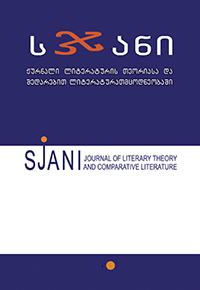Homme თუ Femme (შუასაუკუნეების რაინდული რომანის მაგალითზე)
Homme or Femme (Jn the basis of medievel chivalry romances)
Author(s): Maka ElbaqidzeSubject(s): Gender Studies, Poetry, Theory of Literature
Published by: ლიტერატურის ინსტიტუტის გამომცემლობა
Keywords: masculine; feminine; cult of woman; troubadour poetry; chivalry romance;
Summary/Abstract: Medieval chivalry romance as a depiction of the warrior class’s idealization focuses upon male heroes and not female love-objects. From the standpoint of medieval religious, political and moral theories, men are the agents of the action, and women – only the instruments. In functional categories of act ants (the model of Greimas), main accent is made on the Subject (hero) and Addressor (King), hence, the major functional dichotomy is connected with these characters and not with the object – woman (we can observe the specific interpretation of this model in the “Knight in the Panther’s Skin” of Rustaveli. When the King of Arabia – Rostevan – gives the royal scepter and crown to his daughter Tinatin, she gets all the functions of the King-Sovereign (Addressor-Addressee) together with the royal regalia. At the same time her beloved Avtandil becomes not only the performer of Tinatin’s (Addressor’s) desire and will (She sends him in a quest for the unknown knight),but the Receiver or an Addressee of the both – Tinatin’s love (supreme ideal) and the throne of Arabia).Woman had paradoxical position in courtly culture. She existed to get into trouble and needed the hero to get her out of it. So on the one hand they were privileged centers of attention, on the other – the marginal players in a game whose rules were written by men. They were often desired objects rather than as active subjects in chivalric adventures or quests. The idea of the woman as the source of inspiration behind knightly deeds is present throughout chivalric history from the early twelfth century. Love is taken seriously for the frst time with the coming of the troubadours. The idea that men could become more noble through love was their discovery. Personality and love were connected for the first time. The novelty was the intensity of the feeling. But troubadour poetry was not about women, it was about men in love and their longings. The best demonstration of the ideals of chivalry and love throughout European courtly society is the medieval French chivalry romance. These ideals held men and women to different standards of conduct. According to Roberta L. Kruger, notions of idealized “masculine” and “feminine” comportment were so forcefully articulated in medieval romances that their outlines survived beyond the Victorian age: men could exercise courage and prudence in the public domains of government and war, ladies should cultivate the arts of adornment, sentimental refinement and mothering Early French chivalry romances (Eneas and others) take up the “question of women” and the debate about gender as one of the fundamental concerns of their narratives. All the works of Chretien de Troyes, author of the most popular Arthurian romances, portray a woman as a catalyst for questions that profoundly trouble the courtly world. He represents women paradoxically – as objects of masculine exchange and as potentially troubling subjects, who engender in men a more “noble” heart. So Arthurian romances, according to Roberta L. Krueger, cast women as alternately dependent and spell-binding figures whose elusive presence was crucial to the knight’s quest for honor. When we speak about the question of the gender in medieval chivalry romancesthe most important factor is the physical location of the characters. As Elizabeth Edwards mentions, “the question “where is” plays important role to find out “who is”. Queens and noble ladies living in castles have different ontological state than damsels living in wild forests. As women are usually the objects of the quest, the forest – the site of mail desires has some feminine quality. The wilderness, the magical and the unexplained thus fall in line with the mystery that is women, from the mail perspective. On the other hand, according to Richard Barber, Knighthood is masculine, aggressive, a battle with rules and limits. “Its heroes and feasts of arms are those of the Iliad as much as of the Chanson de Roland. The distinctive touch of chivalry is missing – the play awaits the heroine. The knight’s lady is unlike anything before or since. The love she inspires is half the worship of the goddess – her place is wholly with the divinities”. We think that this is the main reason that Arthurian women are passive, conservative, non-actors useful only for provoking and rewarding the actions of their knight-agents. They may consciously play female parts to effect transformation of their mail-dominant world, but as Maureen Fries mentions, they act only for knightly benefit. All the female types hold up the mirror to male social values, not female ones. It should be mentioned that both – society and literature in the Middle Ages so neglected and distorted women’s values that female heroes begin as scarce and dwindle practically into non-existence.
Journal: სჯანი
- Issue Year: 2017
- Issue No: 18
- Page Range: 130-141
- Page Count: 12
- Language: Georgian

